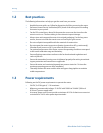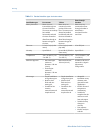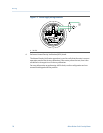
1.2 Best practices
The following information can help you get the most from your meter.
• Handle the meter with care. Follow local practices for lifting or moving the meter.
• Perform a Known Density Verification (KDV) check of the meter prior to installing
the meter in your system.
• For the PFA-coated tines, always fit the protective cover over the tines when the
meter is not in use. The tine coating is not resistant to impact damage.
• Always store and transport the meter in its original packaging. For the long-stem
meters, be sure to include the transit cover secured by the grub screws.
• Do not use liquids incompatible with the materials of construction.
• Do not expose the meter to excessive vibration (greater than 0.5 g continuously).
Vibration levels in excess of 0.5 g can affect the meter accuracy.
• For optimal performance of the meter, ensure the operating conditions correspond
to the meter calibration range and boundary.
• Ensure all piping connections conform to the local and national regulations and
codes of practice.
• Ensure the transmitter housing cover is tightened properly after wiring to maintain
ingress protection and hazardous area approvals.
• Ensure the meter and associated pipework are pressure tested to 1½ times the
maximum operating pressure after installation.
• Thermally insulate the meter and the inlet and bypass-loop pipeline to maintain
stable temperatures.
1.3 Power requirements
Following are the DC power requirements to operate the meter:
• 24 VDC, 0.65 W typical, 1.1 W maximum
• Minimum recommended voltage: 21.6 VDC with 1000 ft of 24 AWG (300 m of
0.20 mm
2
) power-supply cable
• At startup, power source must provide a minimum of 0.5 A of short-term current at
a minimum of 19.6 V at the power input terminals.
Planning
2 Micro Motion Fork Viscosity Meter


















